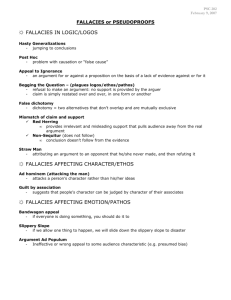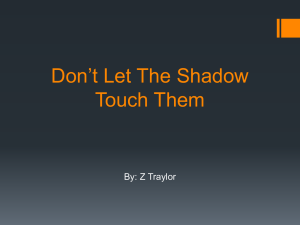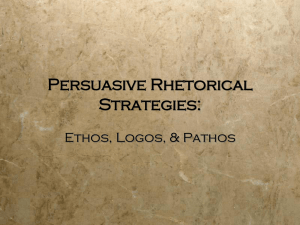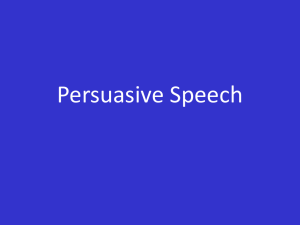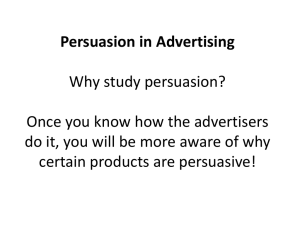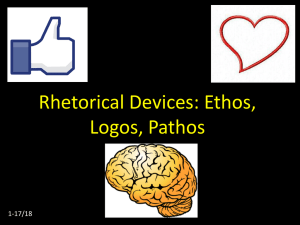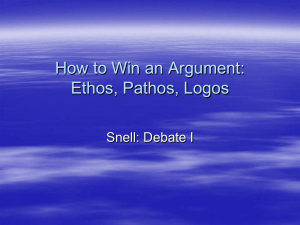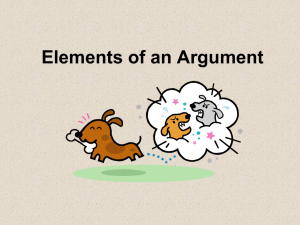Argument: Ethos, Pathos, Logos
advertisement
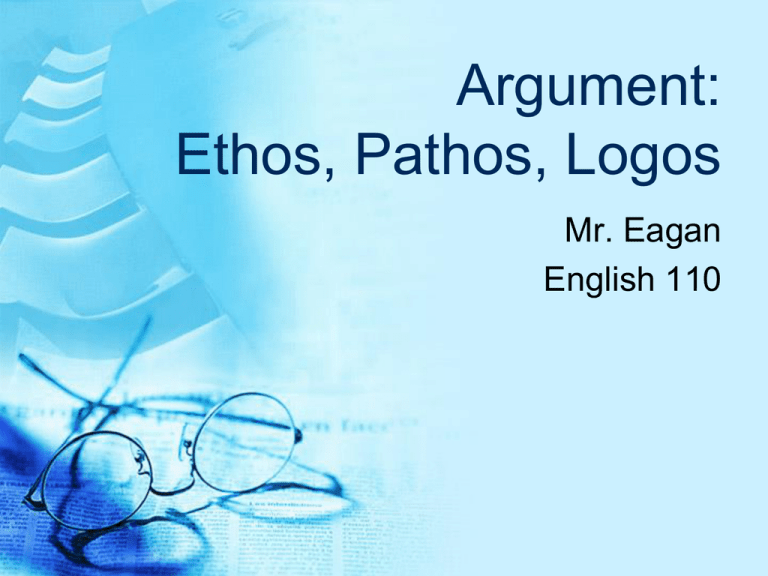
Argument: Ethos, Pathos, Logos Mr. Eagan English 110 All arguments exist in a rhetorical situation What is a Rhetorical Situation? Rhetoric: Using language effectively to persuade, inform, educate, or entertain Rhetorical Situation: The circumstances in which you communicate. Factors which can affect an author’s writing: Age Experiences Gender Location Political Beliefs Parents And Peers Education Audience: To Whom are you Writing? Many of the same factors which affect the writer also affect the audience Age Social class Education Past experience Culture/subculture Expectations Context The “situation” which generates the need for writing Affected by the Time period or timing Location Current events Cultural significance Purpose: Your Reason For Writing What this means… You need to be aware that a rhetorical situation exists every time you write and every time you read. You need to adapt your writing as well as your analysis and use of sources depending on your purpose and your audience. Introduction to Argument All arguments must contain two parts: 1. Claim 2. Support *Also called conclusions and premises (QA Chapter 5, pg. 84) Introduction to Argument CLAIM: States the issue and takes a position on a debatable topic (usually takes the form of a THESIS STATEMENT in a written argument) SUPPORT: Facts, evidence, reasons, examples put together w/ logical reasoning and critical thinking Introduction to Argument Develop and refine your thesis/argument. Do this by asking yourself questions about your chosen topic. (?) Using precise language and establishing a clear position will help both you and your readers. (?) STOP! QA Ex. 5-1, pg. 86 Topics Commercials for weight loss pills on television Taxing new cars according to their mileage Athletes’ use of steroids and performance-enhancing drugs Requiring students to undertake volunteer or community service Introduction to Argument Persuasive Appeals: Ethos - Establishes the writer/speaker as a credible/(ethical or moral) person. Pathos - Appeals to an audience’s values and beliefs through emotion/empathy. Logos - The use of sound reasoning or logic. Qualities of Ethos Demonstrating knowledge Establishing common ground Demonstrating fairness Ethical fallacies: ad hominem, guilt by association Examples Ethos - “I am a husband, a father, and a taxpayer. I have served on the school board for 20 years. I deserve your vote for city council.” Such an appeal attempts to persuade by calling attention to the writer’s/speaker’s character. It says in effect: I’m a great person so you should believe what I’m telling you. Ethos does not concern the veracity of the argument, only its appeal. (I am a credible speaker.) (?) Qualities of Pathos Using description and concrete language Using figurative language (metaphors, similes, analogies) Shaping appeal to audience Emotional fallacies: bandwagon appeal, flattery, in-crowd appeal, veiled threats, loaded language, false analogies Examples Pathos - “ Government-run healthcare will have ‘death squads’ to decide which citizens will live and which will die.” Such an appeal attempts to persuade by stirring the emotions of the audience and attempts to create any number of emotions like fear, sadness, contentment, joy, and pride. Pathos does not concern the veracity of the argument, only its appeal. (QA pg. 88) (?) Qualities of Logos Providing examples and precedents Citing authority and testimony Establishing causes and effects Using inductive and deductive reasoning Logical fallacies: begging the question, post hoc, non sequiter, false dichotomy, hasty generalization, oversimplification Examples Logos - “All humans are mortal. You are a human. Therefore, you are mortal.” This is called a syllogism. Logical arguments take this form through the use of rhetorical devices like process analysis, comparison/contrast, cause/effect, etc. (?) Examples Logos - “Some politicians are corrupt. Therefore, Senator Jones may be corrupt.” This is called an enthymeme. It is like a syllogism but the conclusion is based on inference rather than evidence. The syllogism leads to a necessary conclusion from universally true premises, and the enthymeme leads to a tentative conclusion from probable premises. When Reading for Ethos Note how the author establishes a persona Note how the author establishes credibility Note any revelation of the author’s credentials or personal history. When Reading for Pathos Note the primary audience for the text Note the emotional appeals the author makes Note the author’s expectations of the audience. When Reading for Logos Note the claims the author makes. Note the data the author provides in support of the claims. Note the conclusion the author draws When using Ethos, ask yourself Have I established a credible persona? Have I established my credibility? Have I expressed my knowledge and expertise of the topic? When using Pathos, ask yourself Have I considered the primary audience and the type of background they have? Does my audience agree with me or will I have to persuade them of the validity of my argument? How will I make my paper appeal to my audience? When using Logos, ask yourself Have I established the purpose for my text? Have I established a clear, reasonable, and logical progression of my ideas? Have I addressed opposing arguments or perspectives? Toulmin Logic CLAIM: a variation of a thesis statement. If needed, the claim is qualified or limited SUPPORT: reasons or evidence, moving from broad reasons to specific data and details, support the claim WARRANTS: The writer’s underlying assumptions, which are often implied rather than stated. Warrants may also need support. Toulmin Model Read section 5f in your QA (pg. 89) STOP! QA Ex. 5-2, pg. 89-90 Applying what you’ve learned QA Exercise 5-3, pg. 91 QA Exercise 5-4, pg. 93 QA Exercise 5-5, pg. 94

